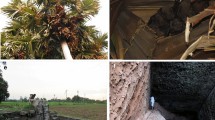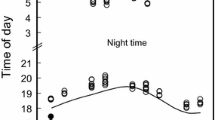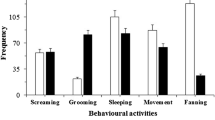Summary
The times of onset and completion of the hunting flights of three colonies of neotropical bats, each comprising 100–200 individuals, were observed for nine months. The colonies were of different species: Molossus ater (M.a.) and Molossus molossus (M.m.) of the Molossidae, and Myotis nigricans (My. n.) of the Vespertilionidae. Individuals of Phyllostomus hastatus (P.h., Phyllostomidae) were also observed. All the bats roosted in a building near Restrepo, Colombia (4°16′N, 73°34′W). Times of emergence in the evening and the return of the last animals in the morning were recorded on 2 to 3 successive days each month. For all bats, the emergence time changed in parallel with that of sunset, and the return paralleled sunrise (Fig. 1). Accordingly, the duration of the activity period is positively correlated with the duration of the night. No annual periodic changes in phase (re sunset/sunrise) of the onset and end of flight activity could be demonstrated, but there was a close relationship between the timing of activity and particular light intensities during twilight (Fig. 4). The first flyers of M.a. appear at the highest intensity (30–300 lx) and those of My. n. at the lowest (0.1–5 lx); the last flyers to return appear in the opposite sequence. For each species, the return to the roost usually occurs at a lower intensity than the departure. These findings, made with four neotropical bat species, differ from those of Subbaraj and Chandrashekaran (1977) with the emballonurid bat Taphozous that they studied at 9°58′ N in India. The ecological factors that may play a role in timing the flight activity of tropical bats are discussed. “Sunset-related timing”, based on the combined effect of (a) the circadian oscillation in “arousal” and (b) the transition during twilight to a light-intensity range with reduced inhibition of activity (lightsampling behavior), tends to be the rule in tropical bats; “time-of-day-related timing” is the exception.
Similar content being viewed by others
References
Anuario del Observatorio Astronomico Nacional: Universidad Nacional de Colombia, Bogotá 1971, 1972
Aschoff, J.: Phasenlage der Tagesperiodik in Abhängigkeit von Jahreszeit und Breitengrad. Oecologia (Berl.) 3, 125–165 (1969)
Aschoff, J., Gwinner, E., Kureck, A., Müller, K.: Diel rhythms of chaffinches Fringilla coelebs L., tree shrews Tupaia glis L. and hamsters Mesocricetus auratus L. as a function of season at the arctic circle. Oikos, Suppl. 13, 91–100 (1970)
Aschoff, J., Wever, R.: Beginn und Ende der täglichen Aktivität freilebender Vögel. J. Orn. 103, 1–27 (1962)
Bay, F.A.: Untersuchungen zur Lichtsteuerung der Aktivitätsperiodik von Fledermäusen (Myotis myotis Borkh. 1797 und Phyllostomus discolor A. Wagner 1843). Diss., Tübingen (1976)
Daan, S., Aschoff, J.: Circadian rhythms of locomotor activity in captive birds and mammals: their variations with season and latitude. Oecologia (Berl.) 18, 269–316 (1975)
DeCoursey, G., DeCoursey, P.J.: Adaptive aspects of activity rhythms in bats. Biol. Bull. 126, 14–27 (1964)
Erkert, H.G.: Der Einfluß des Mondlichtes auf die Aktivitätsperiodik nachtaktiver Säugetiere. Oecologia (Berl.) 14, 269–287 (1974)
Erkert, H.G.: Lunarperiodic variation of the phase-angle difference in nocturnal animals under natural Zeitgeber-conditions near the equator. Int. J. Chronobiol. 4, 125–138 (1976)
Erkert, H.G., Kracht, S.: Evidence for ecological adaptation of circadian systems. Circadian activity rhythms of neo-tropical bats and their re-entrainment after phase shifts of the Zeitgeber-LD. Oecologia (Berl.) 32, 71–78 (1978)
Erkert, S.: Der Einfluß des Lichtes auf die Aktivität von Flughunden (Megachiroptera). Z. Vergl. Physiol. 67, 243–272 (1970)
Griffin, D.R., Welsh, J.H.: Activity rhythms in bats under constant external conditions. J. Mammal. 18, 337–342 (1937)
Krüll, F.: Zeitgebers for animals in the continuous daylight of high arctic summer. Oecologia (Berl.) 24, 149–157 (1976)
Laufens, G.: Freilanduntersuchungen zur Aktivitätsperiodik dunkelaktiver Säuger. Diss., Köln (1972)
Menaker, M.: The free running period of the bat clock; seasonal variations at low body temperature. J. Cell Comp. Physiol. 57, 81–86 (1961)
Nyholm, E.S.: Zur Ökologie von Myotis mystacinus (Leisl.) und M. daubentoni (Leisl.) (Chiroptera). Ann. Zool. Fenn. 2, 77–123 (1965)
Rawson, K.S.: Effects of tissue temperature on mammalian activity rhythms. Cold Spring Harb. Symp. Quant. Biol. 15, 105–113 (1960)
Subbaraj, R., Chandrashekaran, M.K.: “Rigid” internal timing in the circadian rhythm of flight activity in a tropical bat. Oecologia (Ber.) 29, 341–348 (1977)
Voûte, A.M., Sluiter, J.W., Grimm, M.P.: The influence of the natural light-dark cycle on the activity rhythm of pond bats (Myotis dasycneme Boie, 1825) during summer. Oecologia (Berl.) 17, 221–243 (1974)
Author information
Authors and Affiliations
Additional information
Supported by the Deutsche Forschungsgemeinschaft (Er 59/1-3+6)
Rights and permissions
About this article
Cite this article
Erkert, H.G. Sunset-related timing of flight activity in neotropical bats. Oecologia 37, 59–67 (1978). https://doi.org/10.1007/BF00349991
Received:
Issue Date:
DOI: https://doi.org/10.1007/BF00349991




